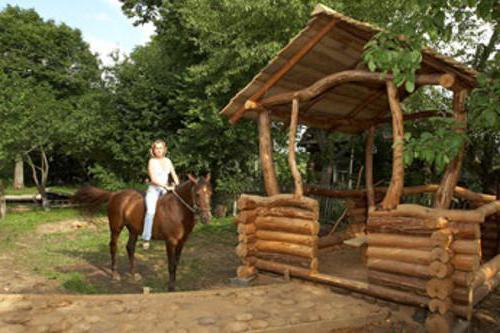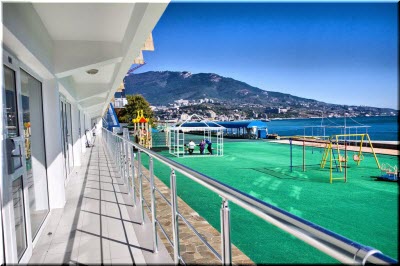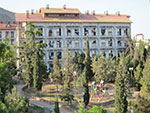The ancient Rani-ki-vav well is an architectural marvel in India. Unique well of Rani Ki Vav
Rani Key Wav (Rani Ki Vav) - a stepped well of the 11th century, located in the Indian city of Patan on the banks of the Saraswati River. It is believed that the well was built by Udayamati, widowed by Queen Bhimdeva I (1022 - 1063 AD) in memory of the king. Bhimdev was the son of Mularaj, the founder of the Solanka dynasty in Patan. The well was later flooded by the neighboring Saraswati River and lost until the late 1980s, when archaeologists discovered and unearthed it. During excavations, magnificent carvings and statues of the well were found in pristine condition.
Let's look at it in more detail ...

The name "Rani-ki-vav" is translated as "Well of the Queen's Steps." Under his last step, which descends to the water, they discovered a 30-meter secret passage leading to the city of Sidhpur. Most likely, it was built in case of war, for the evacuation of the rulers of Patan. In June 2014, Rani-ki-vav was listed as a UNESCO World Heritage Site.
A stepped well is a distinctive form of groundwater and water storage systems in the Indian subcontinent. Such structures were built from the 3rd millennium BC, evolving over time from a simple pit in the sandy soil to carefully thought-out multi-story works of art and architecture. Rani-ki-Vav was built at a time when the skill of erecting wells was perfected. The architectural style of Maru-Guryar reflects the grace of this complex technique and the beauty of detail and proportion. Rani Key Waw is the king of stepped wells in India. Chand Baori in Rajasthan is another exceptional example of this technology.

The well, built in the stepped style of the maru-gurjar, has the shape of an inverted cone. Its staircase is decorated with 500 large and about 1000 small sculptures. The water tank is located at a depth of 23 meters.
Designed as an inverted temple, the well highlights the inviolability of water. It is divided into seven flights of stairs with sculptural groups of high artistic level. There are more than 500 large sculptures and more than a thousand small ones that combine religious, mythological and secular images, often referring to literary works. The fourth level is the deepest and leads into a rectangular tank measuring 9.5 by 9.4 meters, with a depth of 23 meters. The well is located at the lowest level and consists of a shaft 10 meters in diameter and 30 meters deep. The building itself has dimensions of 64 by 20 meters.

At the bottom of the steps is the entrance to the 30-kilometer-long tunnel leading to the city of Sidhpur near Patan. The tunnel was built specifically for the king, who could use it in case of defeat during the war. Currently, the passage is blocked by stones and dirt.
In the 13th century, geotectonic changes led to a major flood and the disappearance of the Saraswati River, after which the well ceased to fulfill its direct functions. For almost seven centuries, the well disappeared under a thick layer of dust and silt, which allowed this miracle of architecture to be preserved in perfect form to this day. The well was rediscovered less than 30 years ago.




























Rani Key Wav (Rani Ki Vav) - a stepped well of the 11th century, located in the Indian city of Patan on the banks of the Saraswati River. It is believed that the well was built by Udayamati, widowed by Queen Bhimdeva I (1022 - 1063 AD) in memory of the king. Bhimdev was the son of Mularaj, the founder of the Solanka dynasty in Patan. The well was later flooded by the neighboring Saraswati River and lost until the late 1980s, when archaeologists discovered and unearthed it. During excavations, magnificent carvings and statues of the well were found in pristine condition.
Let's look at it in more detail ...

The name "Rani-ki-vav" is translated as "Well of the Queen's Steps." Under his last step, which descends to the water, they discovered a 30-meter secret passage leading to the city of Sidhpur. Most likely, it was built in case of war, for the evacuation of the rulers of Patan. In June 2014, Rani-ki-vav was listed as a UNESCO World Heritage Site.
A stepped well is a distinctive form of groundwater and water storage systems in the Indian subcontinent. Such structures were built from the 3rd millennium BC, evolving over time from a simple pit in the sandy soil to carefully thought-out multi-story works of art and architecture. Rani-ki-Vav was built at a time when the skill of erecting wells was perfected. The architectural style of Maru-Guryar reflects the grace of this complex technique and the beauty of detail and proportion. Rani Key Waw is the king of stepped wells in India. Chand Baori in Rajasthan is another exceptional example of this technology.

The well, built in the stepped style of the maru-gurjar, has the shape of an inverted cone. Its staircase is decorated with 500 large and about 1000 small sculptures. The water tank is located at a depth of 23 meters.
Designed as an inverted temple, the well highlights the inviolability of water. It is divided into seven flights of stairs with sculptural groups of high artistic level. There are more than 500 large sculptures and more than a thousand small ones that combine religious, mythological and secular images, often referring to literary works. The fourth level is the deepest and leads into a rectangular tank measuring 9.5 by 9.4 meters, with a depth of 23 meters. The well is located at the lowest level and consists of a shaft 10 meters in diameter and 30 meters deep. The building itself has dimensions of 64 by 20 meters.

At the bottom of the steps is the entrance to the 30-kilometer-long tunnel leading to the city of Sidhpur near Patan. The tunnel was built specifically for the king, who could use it in case of defeat during the war. Currently, the passage is blocked by stones and dirt.
In the 13th century, geotectonic changes led to a major flood and the disappearance of the Saraswati River, after which the well ceased to fulfill its direct functions. For almost seven centuries, the well disappeared under a thick layer of dust and silt, which allowed this miracle of architecture to be preserved in perfect form to this day. The well was rediscovered less than 30 years ago.




























Rani Ki Vav (Rani Ki Vav) - a stepped well of the 11th century, located in the Indian city of Patan on the banks of the Saraswati River. It is believed that the well was built by Udayamati, widowed by Queen Bhimdeva I (1022 - 1063 AD) in memory of the king. Bhimdev was the son of Mularaj, the founder of the Solanka dynasty in Patan. The well was later flooded by the neighboring Saraswati River and lost until the late 1980s, when archaeologists discovered and unearthed it. During excavations, magnificent carvings and statues of the well were found in pristine condition.

The name "Rani-ki-vav" is translated as "Well of the Queen's Steps." Under his last step, which descends to the water, they discovered a 30-meter secret passage leading to the city of Sidhpur. Most likely, it was built in case of war, for the evacuation of the rulers of Patan. In June 2014, Rani-ki-vav was listed as a UNESCO World Heritage Site.
A stepped well is a distinctive form of groundwater and water storage systems in the Indian subcontinent. Such structures were built from the 3rd millennium BC, evolving over time from a simple pit in the sandy soil to carefully thought-out multi-story works of art and architecture. Rani-ki-Vav was built at a time when the skill of erecting wells was perfected. The architectural style of Maru-Guryar reflects the grace of this complex technique and the beauty of detail and proportion. Rani Key Waw is the king of stepped wells in India. Chand Baori in Rajasthan is another exceptional example of this technology.

The well, built in the stepped style of the maru-gurjar, has the shape of an inverted cone. Its staircase is decorated with 500 large and about 1000 small sculptures. The water tank is located at a depth of 23 meters.
Designed as an inverted temple, the well highlights the inviolability of water. It is divided into seven flights of stairs with sculptural groups of high artistic level. There are more than 500 large sculptures and more than a thousand small ones that combine religious, mythological and secular images, often referring to literary works. The fourth level is the deepest and leads into a rectangular tank measuring 9.5 by 9.4 meters, with a depth of 23 meters. The well is located at the lowest level and consists of a shaft 10 meters in diameter and 30 meters deep. The building itself has dimensions of 64 by 20 meters.

At the bottom of the steps is the entrance to the 30-kilometer-long tunnel leading to the city of Sidhpur near Patan. The tunnel was built specifically for the king, who could use it in case of defeat during the war. Currently, the passage is blocked by stones and dirt.
In the 13th century, geotectonic changes led to a major flood and the disappearance of the Saraswati River, after which the well ceased to fulfill its direct functions. For almost seven centuries, the well disappeared under a thick layer of dust and silt, which allowed this miracle of architecture to be preserved in perfect form to this day. The well was rediscovered less than 30 years ago.

















Rani Key Wav (Rani Ki Vav) - a stepped well of the 11th century, located in the Indian city of Patan on the banks of the Saraswati River. It is believed that the well was built by Udayamati, widowed by Queen Bhimdeva I (1022 - 1063 AD) in memory of the king. Bhimdev was the son of Mularaj, the founder of the Solanka dynasty in Patan. The well was later flooded by the neighboring Saraswati River and lost until the late 1980s, when archaeologists discovered and unearthed it. During excavations, magnificent carvings and statues of the well were found in pristine condition.
Let's look at it in more detail ...
Photo 2. 
The name "Rani-ki-vav" is translated as "Well of the Queen's Steps." Under his last step, which descends to the water, they discovered a 30-meter secret passage leading to the city of Sidhpur. Most likely, it was built in case of war, for the evacuation of the rulers of Patan. In June 2014, Rani-ki-vav was listed as a UNESCO World Heritage Site.
A stepped well is a distinctive form of groundwater and water storage systems in the Indian subcontinent. Such structures were built from the 3rd millennium BC, evolving over time from a simple pit in the sandy soil to carefully thought-out multi-story works of art and architecture. Rani-ki-Vav was built at a time when the skill of erecting wells was perfected. The architectural style of Maru-Guryar reflects the grace of this complex technique and the beauty of detail and proportion. Rani Key Waw is the king of stepped wells in India. Chand Baori in Rajasthan is another exceptional example of this technology.
Photo 3. 
The well, built in the stepped style of the maru-gurjar, has the shape of an inverted cone. Its staircase is decorated with 500 large and about 1000 small sculptures. The water tank is located at a depth of 23 meters.
Designed as an inverted temple, the well highlights the inviolability of water. It is divided into seven flights of stairs with sculptural groups of high artistic level. There are more than 500 large sculptures and more than a thousand small ones that combine religious, mythological and secular images, often referring to literary works. The fourth level is the deepest and leads into a rectangular tank measuring 9.5 by 9.4 meters, with a depth of 23 meters. The well is located at the lowest level and consists of a shaft 10 meters in diameter and 30 meters deep. The building itself has dimensions of 64 by 20 meters.
Photo 4. 
At the bottom of the steps is the entrance to the 30-kilometer-long tunnel leading to the city of Sidhpur near Patan. The tunnel was built specifically for the king, who could use it in case of defeat during the war. Currently, the passage is blocked by stones and dirt.
In the 13th century, geotectonic changes led to a major flood and the disappearance of the Saraswati River, after which the well ceased to fulfill its direct functions. For almost seven centuries, the well disappeared under a thick layer of dust and silt, which allowed this miracle of architecture to be preserved in perfect form to this day. The well was rediscovered less than 30 years ago.
Photo 5. 
Photo 6. 
Photo 7. 
Photo 8. 
Photo 9. 
Photo 10. 
Photo 11. 
Photo 12. 
Photo 13. 
Photo 14. 
Photo 15. 
Photo 16. 
Photo 17. 
Photo 18. 
Photo 19. 
Photo 20. 
Photo 21. 
Photo 22. 
Photo 23. 
Photo 24. 
Photo 25. 
Photo 26. 
Photo 27. 
Photo 28. 
Photo 29. 
Photo 30. 
Photo 31. 

Rani Ki Vav (Rani Ki Vav) - a stepped well of the 11th century, located in the Indian city of Patan on the banks of the Saraswati River. It is believed that the well was built by Udayamati, widowed by Queen Bhimdeva I (1022 - 1063 AD) in memory of the king. Bhimdev was the son of Mularaj, the founder of the Solanka dynasty in Patan. The well was later flooded by the neighboring Saraswati River and lost until the late 1980s, when archaeologists discovered and unearthed it. During excavations, magnificent carvings and statues of the well were found in pristine condition.
The name "Rani-ki-vav" is translated as "Well of the Queen's Steps." Under his last step, which descends to the water, they discovered a 30-meter secret passage leading to the city of Sidhpur. Most likely, it was built in case of war, for the evacuation of the rulers of Patan. In June 2014, Rani-ki-vav was listed as a UNESCO World Heritage Site.
A stepped well is a distinctive form of groundwater and water storage systems in the Indian subcontinent. Such structures were built from the 3rd millennium BC, evolving over time from a simple pit in the sandy soil to carefully thought-out multi-story works of art and architecture. Rani-ki-Vav was built at a time when the skill of erecting wells was perfected. The architectural style of Maru-Guryar reflects the grace of this complex technique and the beauty of detail and proportion. Rani Key Waw is the king of stepped wells in India. Chand Baori in Rajasthan is another exceptional example of this technology.

The well, built in the stepped style of the maru-gurjar, has the shape of an inverted cone. Its staircase is decorated with 500 large and about 1000 small sculptures. The water tank is located at a depth of 23 meters.
Designed as an inverted temple, the well highlights the inviolability of water. It is divided into seven flights of stairs with sculptural groups of high artistic level. There are more than 500 large sculptures and more than a thousand small ones that combine religious, mythological and secular images, often referring to literary works. The fourth level is the deepest and leads into a rectangular tank measuring 9.5 by 9.4 meters, with a depth of 23 meters. The well is located at the lowest level and consists of a shaft 10 meters in diameter and 30 meters deep. The building itself has dimensions of 64 by 20 meters.

At the bottom of the steps is the entrance to the 30-kilometer-long tunnel leading to the city of Sidhpur near Patan. The tunnel was built specifically for the king, who could use it in case of defeat during the war. Currently, the passage is blocked by stones and dirt.
In the 13th century, geotectonic changes led to a major flood and the disappearance of the Saraswati River, after which the well ceased to fulfill its direct functions. For almost seven centuries, the well disappeared under a thick layer of dust and silt, which allowed this miracle of architecture to be preserved in perfect form to this day. The well was rediscovered less than 30 years ago.




